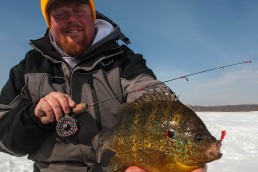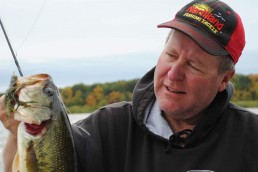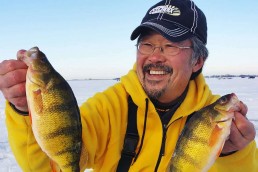Pinpoint Fish in Fall for Great Action on Ice
SHARE THIS POST
It’s probably the most universally ignored piece of advice in all of fishing: In the fall, get out in the boat and find fish. Check weeds and other cover so you know their condition right before ice forms. If you do a good job of this, you can walk right out over the top of fish, drill one set of holes and start catching. If you don’t make time to do pre-ice scouting from a boat, you will face drilling many more holes as you search for early-ice action.
“Pretty simple, and extremely productive,” says Northland pro, Chip Leer, “but very few people actually do it. You can’t believe how much gas you have to run through an auger to look for fish the old way. No matter how many holes you drill, you can’t replace the precision and thoroughness of scouting from a boat.”
No argument from Tony Roach, another top pro on the Northland team. Roach guides year ‘round in central Minnesota, from sprawling Mille Lacs to countless smaller lakes, some tucked away in the woods.
“If I had to try to get on fish for my customers by drilling holes,” Roach says, “I wouldn’t have very many customers.”
Don’t miss the boat
How badly are we missing the boat if we don’t scout for the upcoming ice season when we can zip around on the water?
“It really shortens the learning curve,” Roach stresses. “It’s a lot tougher to go out and drill holes to do it, especially over big basin areas. But same thing on structure—fish relate to the same things at early ice that they do in late fall.”
How soon is too soon to start pre-ice scouting in a boat? How close to ice-up do we have to be in order for the information on habitat condition and fish location to be reliable?
“Timing is always relative,” Roach says. “You start scouting sooner the farther north you go, because the ice is coming sooner. The farther south you go, you can wait a bit longer, into November sometimes.
“Where I live, in central Minnesota, I spend a lot of time looking in October. There are lots of panfish wintering areas, for example. They’re already in those areas come late September into October. If you can get out there, look around, find some fish and put in GPS coordinates and icons, you’re going to have a much better grasp of what’s going on in your lakes as soon as the ice is ready to walk on.
“Those fish tend to stay where you found them from about mid-October on. Get out there on a nice day and look things over. I tell a lot of folks, if they’re up here checking deer stands or grouse hunting, spend midafternoon in the boat looking, marking spots. You’ll learn a lot about where you should be fishing in the winter. For my own work, I tend to get serious about it after turnover, mid- to late October and early November.”
What the heck is turnover?
In simple English, here is what fall turnover is:
During the heat of summer, surface temperatures in many bodies of water (unless current is fast and constant) warm to a point that there is a big difference in temperature from top to bottom. Colder water is denser, so it sinks toward the bottom, forcing warmer water to remain at the top. In many lakes, a relatively narrow band forms that features a rapid change of water temperature. This narrow layer is called the thermocline, and many fish spend all their time in or above it, mainly because oxygen is limited below it. In fall, water temps drop to the point that the surface layer becomes denser and sinks. This eventually causes a mixing of water from top to bottom, hence the name turnover to describe it. Turnover is a time of relative chaos in the fish’s world, but after it’s over, fish settle into spots they will probably occupy after the ice comes.
“It throws the fishing off for a period of time,” Roach says. “It changes fish location dramatically in a lot of cases, so I usually wait until after the turnover before I start doing my [pre-ice] scouting.”
Look nearby
Pinpointing spots holding fish at late fall is the gold standard head start to great ice action. But there’s no guarantee those fish will be in the spot at the moment you drill holes.
“Your spots should be good after the ice comes,” says another Northland ice pro, Brian Brosdahl, “but sometimes the fish aren’t there when you get there.”
Are you enjoying this post?
You can be among the first to get the latest info on where to go, what to use and how to use it!
Those disappearing fish are often nearby, and that’s why “Bro” makes it a point to look for similar spots close to his main spots as he conducts in-the-boat research.
“I always check out similar areas to any place I find fish,” he says. “When ice fishing comes, if I get to a spot and don’t see fish, those backup spots can save the day. The best ones are close, 100 feet or less, but they can be farther away than that, especially on larger lakes.”
Bro offers this additional tip: Slide up and down on your main spots if fish are not exactly where you left them.
“Food sources,” he says, “might be shallower or deeper, but in the same area. That can cause your fish to move a bit.”
Gear for pre-ice scouting
The standby for pre-ice scouting is a sonar unit (depth finder), along with GPS to save spots so you can easily find them after the ice forms.
Most anglers these days have a depth finder, but not everybody has GPS.
Or do they?
Keep in mind that your smartphone can probably function as GPS with a free or inexpensive app. There are also apps that load detailed contour maps onto the phone display. Spots can be saved while scouting, and then returned to on the ice.
Another key piece of gear for both Roach and Bro is an underwater viewing system.
“I like to search out green weeds,” Roach says. “Weeds grow differently every year. You can have cabbage or coontail that’s really thick and lush one year, and the next year it’s sparse in that same spot.”
On bigger lakes, Roach uses his big boat, which is rigged with all the latest electronics to make scouting easier. But he targets a lot of small, backcountry lakes—especially for panfish and especially at early ice—so he sets up a small recon rig for those.
“On little lakes,” he says, “the ramps typically cannot handle my big boat, so I don’t have StructureScan and all the features on my main sonar units. I have a winter sonar unit that I put in a little 14-foot boat. I put a little water in the bottom of the boat and read right through the hull, and I bring a little handheld GPS so I can go along marking my spots.”
Between the time you winterize the boat and the time the ice is ready for walking on, how much do those fish move, in reality, from where they were prior to ice-up?
“Not very much,” says Roach, “and that goes for panfish, walleyes, pike, everything. I’ve found so many walleye spots where they were exactly where I left them in the fall. If you get out there on a nice fall day in the boat, you can get all your scouting done and look like a hero on the ice.”
MWO
SHARE THIS POST
Did you enjoy this post?
You can be among the first to get the latest info on where to go, what to use and how to use it!
MWO
We believe being outdoors is good. With more than 1,000 articles each year, MidWest Outdoors magazine is all about sharing outdoor experiences with you—where to go, what to use and how to use it… whether you’re close to home or on that trip of a lifetime.


